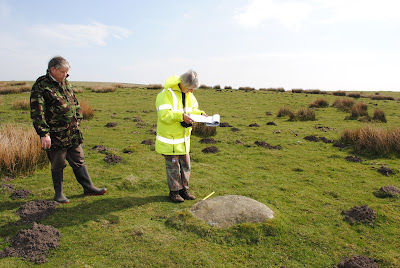In 1949,
the archaeologist Lady (Aileen) Fox, the wife of Sir Cyril Fox who
was the Director of the National Museum of Wales, wrote a letter
(probably to OGS Crawford, the head of the archaeological division in
the Ordnance Survey). In it, she mentioned a cup-marked stone that
had been found in an allotment in Bargoed, and was known locally as
‘The Marrying Stone’.
Cup-marked
stones were created during the Neolithic, or New Stone Age (roughly
4400 - 2300 BC). Using pointed stone tools, Neolithic people dug out
circular depressions a couple of inches across on rocks that were
softer than the tools. There might be just one cup-mark or there
might be a group of several of them. The rocks might be natural
outcrops or they might have been moved by humans, perhaps to become
standing stones. Cup-marks are the commonest rock art motifs found
in prehistoric Britain. Although rock art is common in some parts of
Britain, such as North-east England, it is very rare in Wales.
However, one cup-marked stone, called Maen Cattwg, can be seen near a
footpath in fields just outside Gelligaer village.
 |
| Maen Cattwg cup marked stone |
Above is all the information we have at the moment about
the Marrying Stone. It was written down on an index card by an
archaeologist called Norman Quinnell who worked for the Ordnance
Survey and was responsible for carrying out an archaeological survey
of South Wales in the 1950s. His writing is not very easy to read so
we have added a transcription. None of the people he asked when he
visited Bargoed knew anything about it. Do you?
We don’t
even have a clear idea about what it looked like, although when Lady
Fox saw it, it had cement around the top suggesting that it had been
built into a wall. It could just have been a chunk of stone with
cupmarks. Or it could have been a large rock the one in the photos,
with one or more cupmarks on it.
The
stone was found nearly 80 years ago, so anyone still alive who was
around then was most probably a child at the time. Or there might be
people who have been told about it by their parents or grandparents.
The name ‘The Marrying Stone’ suggests that there might have been
traditions about it connected with weddings. Have you heard any of
these?
If you
have any information, can you contact Janine Reed at Groundwork
Caerphilly (tel 01495 233160,
email Janine.Reed@groundwork.org.uk)
or Edith Evans at the Glamorgan-Gwent Archaeological Trust (tel
01792-634227, email
edith@ggat.org.uk)
















